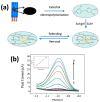Towards Clean and Safe Water: A Review on the Emerging Role of Imprinted Polymer-Based Electrochemical Sensors
- PMID: 34201852
- PMCID: PMC8271813
- DOI: 10.3390/s21134300
Towards Clean and Safe Water: A Review on the Emerging Role of Imprinted Polymer-Based Electrochemical Sensors
Abstract
This review critically summarizes the knowledge of imprinted polymer-based electrochemical sensors for the detection of pesticides, metal ions and waterborne pathogenic bacteria, focusing on the last five years. MIP-based electrochemical sensors exhibit low limits of detection (LOD), high selectivity, high sensitivity and low cost. We put the emphasis on the design of imprinted polymers and their composites and coatings by radical polymerization, oxidative polymerization of conjugated monomers or sol-gel chemistry. Whilst most imprinted polymers are used in conjunction with differential pulse or square wave voltammetry for sensing organics and metal ions, electrochemical impedance spectroscopy (EIS) appears as the chief technique for detecting bacteria or their corresponding proteins. Interestingly, bacteria could also be probed via their quorum sensing signaling molecules or flagella proteins. If much has been developed in the past decade with glassy carbon or gold electrodes, it is clear that carbon paste electrodes of imprinted polymers are more and more investigated due to their versatility. Shortlisted case studies were critically reviewed and discussed; clearly, a plethora of tricky strategies of designing selective electrochemical sensors are offered to "Imprinters". We anticipate that this review will be of interest to experts and newcomers in the field who are paying time and effort combining electrochemical sensors with MIP technology.
Keywords: bacteria; electrochemical sensors; imprinted polymers; metal ions; pesticides.
Conflict of interest statement
The authors declare no conflict of interest.
Figures


























Similar articles
-
Molecularly imprinted polymer-based electrochemical impedimetric sensors on screen-printed carbon electrodes for the detection of trace cytokine IL-1β.Biosens Bioelectron. 2022 May 15;204:114073. doi: 10.1016/j.bios.2022.114073. Epub 2022 Feb 3. Biosens Bioelectron. 2022. PMID: 35144170
-
High-performance disposable electrochemical sensors for creatinine derived from hollow CoNi-LDH@Creatinine-imprinted Poly(methacrylic acid) (i-PMA) composites.Anal Chim Acta. 2025 Apr 8;1346:343768. doi: 10.1016/j.aca.2025.343768. Epub 2025 Feb 3. Anal Chim Acta. 2025. PMID: 40021322
-
Electrochemical impedimetric sensor based on molecularly imprinted polymers/sol-gel chemistry for methidathion organophosphorous insecticide recognition.Talanta. 2014 Dec;130:294-8. doi: 10.1016/j.talanta.2014.07.012. Epub 2014 Jul 18. Talanta. 2014. PMID: 25159412
-
Molecularly Imprinted Polymers Combined with Electrochemical Sensors for Food Contaminants Analysis.Molecules. 2021 Jul 29;26(15):4607. doi: 10.3390/molecules26154607. Molecules. 2021. PMID: 34361757 Free PMC article. Review.
-
Molecularly imprinted polymer-based electrochemical sensors for environmental analysis.Biosens Bioelectron. 2021 Jan 15;172:112719. doi: 10.1016/j.bios.2020.112719. Epub 2020 Oct 20. Biosens Bioelectron. 2021. PMID: 33166805 Review.
Cited by
-
Cationic Covalent Organic Polymer Thin Film for Label-free Electrochemical Bacterial Cell Detection.ACS Sens. 2022 Sep 23;7(9):2743-2749. doi: 10.1021/acssensors.2c01292. Epub 2022 Sep 2. ACS Sens. 2022. PMID: 36053557 Free PMC article.
-
Artificial Olfactory Biohybrid System: An Evolving Sense of Smell.Adv Sci (Weinh). 2023 Feb;10(5):e2204726. doi: 10.1002/advs.202204726. Epub 2022 Dec 18. Adv Sci (Weinh). 2023. PMID: 36529960 Free PMC article. Review.
-
Editorial to the Special Issue SELSA: "Sensors for Environmental and Life Science Applications".Sensors (Basel). 2021 Aug 9;21(16):5353. doi: 10.3390/s21165353. Sensors (Basel). 2021. PMID: 34450795 Free PMC article.
-
A sensitive electrochemical bisphenol A sensor based on molecularly imprinted polydopamine-coated Fe3O4 microspheres.Anal Sci. 2022 Feb;38(2):339-346. doi: 10.2116/analsci.21P278. Epub 2022 Mar 22. Anal Sci. 2022. PMID: 35314980
-
Electrochemical sensors modified with iron oxide nanoparticles/nanocomposites for voltammetric detection of Pb (II) in water: A review.Heliyon. 2024 Apr 16;10(8):e29743. doi: 10.1016/j.heliyon.2024.e29743. eCollection 2024 Apr 30. Heliyon. 2024. PMID: 38665564 Free PMC article. Review.
References
-
- Stradiotto N.R., Yamanaka H., Zanoni M.V.B. Electrochemical sensors: A powerful tool in analytical chemistry. J. Braz. Chem. Soc. 2003;14:159–173. doi: 10.1590/S0103-50532003000200003. - DOI
-
- Branger C., Meouche W., Margaillan A. Recent advances on ion-imprinted polymers. React. Funct. Polym. 2013;73:859–875. doi: 10.1016/j.reactfunctpolym.2013.03.021. - DOI
Publication types
MeSH terms
Substances
Grants and funding
LinkOut - more resources
Full Text Sources
Miscellaneous

